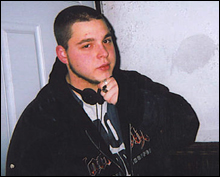 From being physically harassed in my middle-class catholic high school in the mid 1960s to being assaulted in boston’s outdoor cruising areas, i’ve seen a lot of anti-gay violence up close. The closest i’ve come to deadly violence was on November 18, 1980. I had been standing in front of the Ramrod bar in New York’s Greenwich Village, as several dozen men in leather jackets and jeans were chatting and cruising, taking a break from the small, always smoky bar. Soon, I left for the Mineshaft, another west village club, noted for its rowdy thursday two-for-one night. Thirty minutes later, Ronald K. Crumpley fired 40 rounds from a semiautomatic rifle and two pistols into the cluster of men i’d been standing with in front of the ramrod, killing two and wounding six others. Bartenders at the Mineshaft quietly told us what had happened and urged us to be careful, since no one was certain there was only one shooter. In the ’60s and ’70s, public expressions of homosexuality and physical violence were so intricately bound together that, as a community, we simply expected it. In this part of the world, in 2006, things have indeed changed for gay men. That is why the attacks at puzzles lounge in new bedford were truly shocking.
From being physically harassed in my middle-class catholic high school in the mid 1960s to being assaulted in boston’s outdoor cruising areas, i’ve seen a lot of anti-gay violence up close. The closest i’ve come to deadly violence was on November 18, 1980. I had been standing in front of the Ramrod bar in New York’s Greenwich Village, as several dozen men in leather jackets and jeans were chatting and cruising, taking a break from the small, always smoky bar. Soon, I left for the Mineshaft, another west village club, noted for its rowdy thursday two-for-one night. Thirty minutes later, Ronald K. Crumpley fired 40 rounds from a semiautomatic rifle and two pistols into the cluster of men i’d been standing with in front of the ramrod, killing two and wounding six others. Bartenders at the Mineshaft quietly told us what had happened and urged us to be careful, since no one was certain there was only one shooter. In the ’60s and ’70s, public expressions of homosexuality and physical violence were so intricately bound together that, as a community, we simply expected it. In this part of the world, in 2006, things have indeed changed for gay men. That is why the attacks at puzzles lounge in new bedford were truly shocking.
Last Thursday, just after midnight, Jacob D. Robida, an 18-year-old high-school dropout, entered Puzzles Lounge, and after being served two drinks asked if it was “a gay bar.” When told that it was, he assaulted patrons with a handgun and a hatchet, wounding three men, two seriously. He fled home, left a note for his mother that apologized and expressed his love, but added, “I have to go out by my means.” He then took her car and left, picked up his ex-girlfriend Jennifer Bailey in West Virginia, and drove to Arkansas, where he shot and killed a part-time police officer. After a 16-mile chase, Robida crashed his car and then shot Bailey in the head, before he shot himself as he was beset by state troopers and police. He died the following day. According to news reports, when New Bedford police searched Robida’s bedroom they found “homemade posters disparaging African-Americans and Jews; neo-Nazi literature and skinhead paraphernalia,” as well as an empty coffin.

The first response to the attacks, by the police, the media, and spokespeople for gay groups, was that this was a “hate crime” — that is, a crime that specifically targeted homosexuals. Although Bristol District Attorney Paul F. Walsh Jr. has stated that Robida seemed to have no connections to any known groups that promoted an anti-Semitic, racist, or anti-gay ideology, filling one’s bedroom with Nazi regalia suggests at least a serious predisposition to social malignity.
After the attacks, the media reached out to national gay spokespeople such as Matt Foreman, executive director of the National Gay and Lesbian Task Force (NGLTF), who stated that “the hatred and loathing fueling” the New Bedford attacks “is not innate, it is learned” from the likes of James Dobson, of Focus on the Family, Reverend Pat Robertson, and others on the Christian right who are “obsessed with homosexuality.” Clarence Patton, the acting executive director of the National Coalition of Anti-Violence Programs, made a broader argument that such violence was a reaction to queer political organizing. “It happened in Massachusetts during the fight to secure same-sex-marriage rights, it happened in San Francisco for the same reasons.” Neil G. Giuliano, president of the Gay and Lesbian Alliance Against Defamation (GLAAD), saw the New Bedford incident as an attack on the entire gay community: “This act of defamation highlights the need for all of us to do what we can to combat the hatred and bigotry our community still faces.”
These are immediate, even knee-jerk, responses to what is, admittedly, a scary and frightening situation. But these responses emerge not just from a culture of fear, but from a culture that needs to reduce complexity to easily understood sound bites that make people feel better and safer.
Over the past three decades we have created the term “hate crime” — a violent, or sometimes simply verbal, expression of vehement and vicious dislike for a specific group. We have a federal law that adds extra sentencing penalties to crimes that target people because of race, religion, and nationality. Twenty-two states, including Massachusetts, include sexual orientation as a protected category. There has been a decade-long fight by gay-rights groups to include sexual orientation in the federal law, although there is almost no evidence that these laws function as a deterrent. Up until last May, the ACLU had opposed federal legislation for fear that it would interfere with protected free speech.